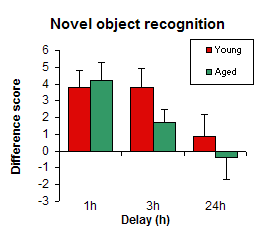Schizophrenia
Patients with schizophrenia exhibit disturbances in information processing and cognitive impairment. These disturbances are clinically investigated with different paradigms of auditory event related potentials (ERP) as well as by appropriate cognitive tests aligned to specific cognitive domains, recommended by MATRICS, CNTRIS and TURNS initiatives, which can be recapitulated in rodents.
Our elegant electrophysiological approach enables detection of translational ERP endpoints such as N1 and MMN-like responses in standard and oddball paradigm stimuli in response to test compounds, benchmarked against NMDA antagonists, (ketamine, MK-801, PCP). Furthermore, our battery of rodent cognition tests provides the opportunity for assessing whether NCEs have the potential utility for treating a range of cognitive impairments associated with schizophrenia compared to atypical antipsychotics such as clozapine.
We also offer ‘classical models’ of positive symptoms, e.g amphetamine-evoked behaviour, using our advanced LABORAS home cage monitoring system.
Disease relevant models we offer include the following:
- Aggression Screening Model
- At Transpharmation, we've applied our expertise in EEG to develop rodent mismatch negativity (MMN) - regarded as one of the most highly-translatable biomarkers for schizophrenia. MMN is a human scalp recorded event related potential (ERP) component elicited by a sound which deviates from a repeating pattern of recent sounds. MMN is generated by a temporo-frontal network including the auditory cortex and is known to be diminished in schizophrenic patients. This disruption can be mimicked by NMDA antagonists (e.g. ketamine) treatment in healthy volunteers. Via collaborations with Cadent and Lundbeck, we have thoroughly validated our MMN protocols with NMDA antagonists such as MK-801, PCP and ketamine in rodents using in-vivo EEG, demonstrating the utility of MMN as a potential translational marker for novel treatments for schizophrenia.
-
This test of recognition memory is based on the tendency of rodents to preferentially explore a novel compared to a familiar object. Test subjects are exposed to a sample stimulus (object), and after a delay of minutes to hours, are presented with the sample object together with a novel object. Memory of the familiar object is gauged by a time difference score spent exploring each object.
Validation Data: Age-dependent impairment in learning and memory assessed by the novel object recognition task.
Aged rats show a decline in novel object recognition at 3h post sample stage, unlike young controls. Both young and aged rats show decline at 24h post sample stage.
- Reversal learning
- Reversal of amphetamine/PCP-induced behaviours using LABORAS